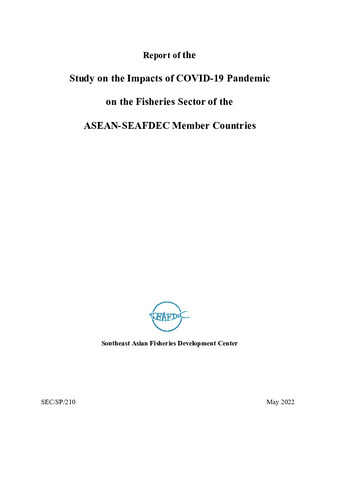| dc.description.abstract | The COVID-19 pandemic that emerged at the end of 2019 and prolonged up to 2022 has severely affected not only the health and life of the people but also the economies, worldwide. Several measures had been imposed to contain and prevent the spread of COVID-19, such as lockdowns, curfews, closing of borders, travel restrictions, among others. Such measures had disrupted all human activities including those engaged in fisheries as well as the whole supply chain of fish and fishery products, resulting in drastic impacts on the fisheries and aquaculture sector of the Southeast Asian region. SEAFDEC in collaboration with the ASEAN–SEAFDEC Member Countries, therefore, conducted the “Study on the Impacts of the COVID-19 Pandemic on the Fisheries and Aquaculture Sector of the ASEAN–SEAFDEC Member Countries” from 2020 until May 2021 with the purposes to: 1) describe the impacts of the COVID-19 pandemic on the fisheries and aquaculture sector of the ASEAN–SEAFDEC Member Countries, 2) identify the mitigation measures and support programs of the countries in response to the impacts of COVID-19, and 3) provide recommendations to mitigate the impacts of COVID-19 and revive the fisheries and aquaculture sector of the ASEAN–SEAFDEC Member Countries after the COVID-19 pandemic as well as mitigate the impacts of other pandemics and disasters on fisheries and aquaculture in the future.
The results of the Study revealed the various impacts of the COVID-19 pandemic on the fisheries and aquaculture sector of the ASEAN–SEAFDEC Member Countries, which could probably magnify into either positive or negative consequences. For capture fisheries and fish processing sub-sectors, the direct impacts were the decrease in number of fishing operations at sea, difficulties in acquiring workers especially migrants for commercial fishery and processing plants, difficulties to access fish ports and cold storage facilities, decreased processing lines, and decrease in the overall quantity of capture fishery production. For the aquaculture sub-sector, the access of fish farmers to their farms was restricted and farmers had to prolong the culture period resulting in the increased aquaculture cost, while several aquaculture inputs were also found to be in shortage or had become more expensive. On the fish trade-related aspect, the major impacts were the decrease in the number and duration of operational markets making the demand for fish and fishery products less, decrease in the number of fish traders, among others. While there were shortages in the supply of fish and fishery products due to restricted fishing and aquaculture activities, some harvested products were not utilized due to inaccessibility to fish ports, cold storage facilities, or markets, resulting in spoilage of the catch. In terms of fishery management, the countries maintained the MCS and other enforcement activities waters and remained a high priority throughout the pandemic. There were difficulties in the monitoring of fishing vessels and fishing activities at sea. While the COVID-19 caused drastic impacts on the economy and well-being of people engaged in the fisheries sector, the decrease in fishing and other activities resulted in the recovery and improved condition of fishery and natural resources.
Based on the results of the Study and views gathered from the ASEAN–SEAFDEC Member Countries, the recommendations were developed for relevant stakeholders in to support the relevant fisheries and aquaculture stakeholders (e.g.fishers, fish farmers, fishery workers, fishing operators, fish traders, consumers, national and local government, fisheries agencies, fisheries officers, NGOs, academe, research institutions, financial institutions, relevant non-fisheries sectors, and others) on how to mitigate the impacts of the COVID-19 pandemic. These recommendations are also intended to revive the fisheries and aquaculture sector of the ASEAN–SEAFDEC Member Countries after the COVID-19 pandemic and mitigate the impacts of other pandemics and disasters that may emerge in the future. The recommendations are categorized into different aspects, namely: 1) Fisheries management; 2) Facilitating movement during curfew/lockdown; 3) Improving cold storage and processing; 4) Market and trade interventions; 5) Financial interventions; 6) Enhancing livelihoods; 7) Facilitating employment and welfare of fish workers; 8) Implementing COVID-19 prevention measures; 9) Enhancing the application of technology; 10) Boosting cooperation among responsible agencies; 11) Promoting cost-effective aquaculture inputs; and 12) Enhancing the application of traceability schemes. | en |

